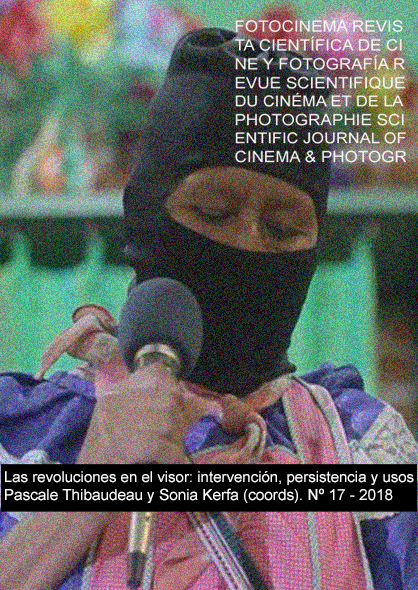Art and ideology in S. M. Eisenstein’s movies
DOI:
https://doi.org/10.24310/Fotocinema.2018.v0i17.5105Keywords:
Eisenstein, Socialist Realism, Kandinsky, Color Theory, Editing.Abstract
Eisenstein, who was born hundred years ago, is considered one of the greatest filmmakers in History. Committed to Bolshevik ideas and as supporter of the October Revolution, he wanted to use film as another vehicle in the awareness of the masses. Although he faced the most orthodox sectors of Stalinism, Eisenstein knew at all times to put into practice a series of theoretical ideas related to sound and color. The implementation of these, not only served for ideological purposes, but also converted their films into authentic works of art. For this, he not only researched in arts and color theory, but also chose to introduce in his work references to other cultures (such as the Kabuki), avant-garde artists (Kandinsky) and musicians such as Prokofiev. The present essay analyzes the connections between Eisenstein and all of them, and specially how he performed these revolutionary ideas.Downloads
Metrics
Publication Facts
Reviewer profiles N/A
Author statements
Indexed in
-
—
- Academic society
- N/A
- Publisher
- Universidad de Málaga
References
Aumont, J. – Marie, M. (1990). Análisis del film. Barcelona: Paidós.
Aumont, J. (1985). Estética del cine. Espacio fílmico, montaje, narración, lenguaje. Barcelona: Paidós.
Ballò, J. (2000). Imágenes del silencio. Los motivos visuales en el cine. Barcelona: Anagrama.
Bordwell, D. (1996). La narración en el cine de ficción. Barcelona: Paidós.
Bordwell, D. (1999). El cine de Eisenstein. Barcelona: Paidós.
Bresson, R. (1979). Notas sobre el cinematógrafo. México: Era.
De Micheli, M. (2001). Las vanguardias artísticas del siglo XX, Madrid: Alianza Editorial.
Dumas, A. (2018). La mise en scène théâtrale de Eisenstein. París. Il était une fois le cinema. http://www.iletaitunefoislecinema.com/chronique/1945/la-mise-en-scene-theatrale-de-eisenstein
Eisenstein, S. M. (Junio – julio 1923). Montaje de atracciones. LEF, (3). Pp. 70-75.
Eisenstein, S. M. (1982). Film essays and a lecture. Princeton: Princeton University Press.
Eisenstein, S. M. (1986). La forma del cine, Buenos Aires: S.XXI.
Eisenstein, S. M. (1990, septiembre). El cine. En La perestroika en el cine. Notas para un ensayo. Cine y más (70), p. 303.
Eisenstein, S. M. (1999). El sentido del cine. México: Siglo XXI.
Golomostock, I. (1991). L’art totalitaire. Union soviétique-III Reich-Italie fasciste-Chine, Paris: Éditions Carré.
Goodwin, J. (1995). Eisenstein, Cinema and History. Chicago: University of Illinois.
Kandinsky, W. (2001). De lo espiritual en el arte. Barcelona: Paidós.
Lenin, V. I. (1975). Sobre arte y literatura. Madrid: Júcar.
Sadoul, G. (1967). Historia del cine mundial. México: Siglo XXI.
Vertov, D. (1973). El cine ojo. Madrid: Fundamentos
Downloads
Additional Files
Published
How to Cite
Issue
Section
License
All contents published in Fotocinema Revista científica de cine y fotografía are protected under the Creative Commons Attribution-NonCommercial-ShareAlike 4.0 International (CC BY-NC-SA 4.0) license. All about this license is available in the following link: <http://creativecommons.org/licenses/by-nc-sa/4.0>
Users can copy, use, redistribute, share and exhibit publicly as long as:
- The original source and authorship of the material are cited (Journal, Publisher and URL of the work).
- It is not used for comercial purposes.
- The existence of the license and its especifications are mentioned.
There are two sets of authors’ rights: moral and property rights. Moral rights are perpetual prerogatives, unrenounceable, not-transferable, unalienable, imprescriptible and inembargable. According to authors’ rights legislation, Fotocinema. Revista científica de cine y fotografía recognizes and respects authors moral rights, as well as the ownership of property rights, which will be transferred to University of Malaga in open access. The property rights are referred to the benefits that are gained by the use or the dissemination of works. Fotocinema. Revista científica de cine y fotografía is published in an open access form and it is exclusively licenced by any means for doing or authorising distribution, dissemination, reproduction, , adaptation, translation or arrangement of works.
Authors are responsable for obtaining the necessary permission to use copyrighted images.














13.png)



